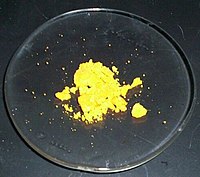This is an old revision of this page, as edited by Beetstra (talk | contribs) at 12:44, 15 February 2012 (Saving copy of the {{chembox}} taken from revid 474848885 of page Iron(III)_chloride for the Chem/Drugbox validation project (updated: '').). The present address (URL) is a permanent link to this revision, which may differ significantly from the current revision.
Revision as of 12:44, 15 February 2012 by Beetstra (talk | contribs) (Saving copy of the {{chembox}} taken from revid 474848885 of page Iron(III)_chloride for the Chem/Drugbox validation project (updated: '').)(diff) ← Previous revision | Latest revision (diff) | Newer revision → (diff)| This page contains a copy of the infobox ({{chembox}}) taken from revid 474848885 of page Iron(III)_chloride with values updated to verified values. |
 | |||
| |||
| Names | |||
|---|---|---|---|
| IUPAC names
Iron(III) chloride Iron trichloride | |||
| Other names
Ferric chloride Molysite Flores martis | |||
| Identifiers | |||
| CAS Number | |||
| 3D model (JSmol) | |||
| ChEBI | |||
| ChemSpider | |||
| PubChem CID | |||
| RTECS number |
| ||
| UN number | 1773 (anhydrous) 2582 (aq. soln.) | ||
InChI
| |||
SMILES
| |||
| Properties | |||
| Chemical formula | FeCl3 | ||
| Molar mass | 162.2 g/mol (anhydrous) 270.3 g/mol (hexahydrate) | ||
| Appearance | green-black by reflected light; purple-red by transmitted light hexahydrate: yellow solid aq. solutions: brown | ||
| Density | 2.898 g/cm (anhydrous) | ||
| Melting point | 306 °C (anhydrous) 37 °C (hexahydrate) | ||
| Boiling point | 315 °C (anhydrous, decomp) 280 °C (hexahydrate, decomp) | ||
| Solubility in water | 74.4 g/100 mL (0 °C) 92 g/100 mL (hexahydrate, 20 °C) | ||
| Solubility in acetone Methanol Ethanol Diethyl ether |
63 g/100 ml (18 °C) highly soluble 83 g/100 ml highly soluble | ||
| Viscosity | 40% solution: 12 cP | ||
| Structure | |||
| Crystal structure | hexagonal | ||
| Coordination geometry | octahedral | ||
| Hazards | |||
| GHS labelling: | |||
| Pictograms |  
| ||
| Signal word | Danger | ||
| Hazard statements | H290, H302, H314 | ||
| Precautionary statements | P234, P260, P264, P270, P273, P280, P301+P312, P301+P330+P331, P303+P361+P353, P304+P340, P305+P351+P338, P310, P321, P363, P390, P405, P406, P501 | ||
| NFPA 704 (fire diamond) |
 | ||
| Flash point | non-flammable | ||
| Except where otherwise noted, data are given for materials in their standard state (at 25 °C , 100 kPa).
| |||
Chemical compound
- Pradyot Patnaik. Handbook of Inorganic Chemicals. McGraw-Hill, 2002, ISBN 0070494398
- HSNO Chemical Classification Information Database, New Zealand Environmental Risk Management Authority
- Various suppliers, collated by the Baylor College of Dentistry, Texas A&M University. (accessed 2010-09-19)
- GHS classification – ID 831, Japanese GHS Inter-ministerial Committee, 2006
Cite error: There are <ref group=Note> tags on this page, but the references will not show without a {{reflist|group=Note}} template (see the help page).

